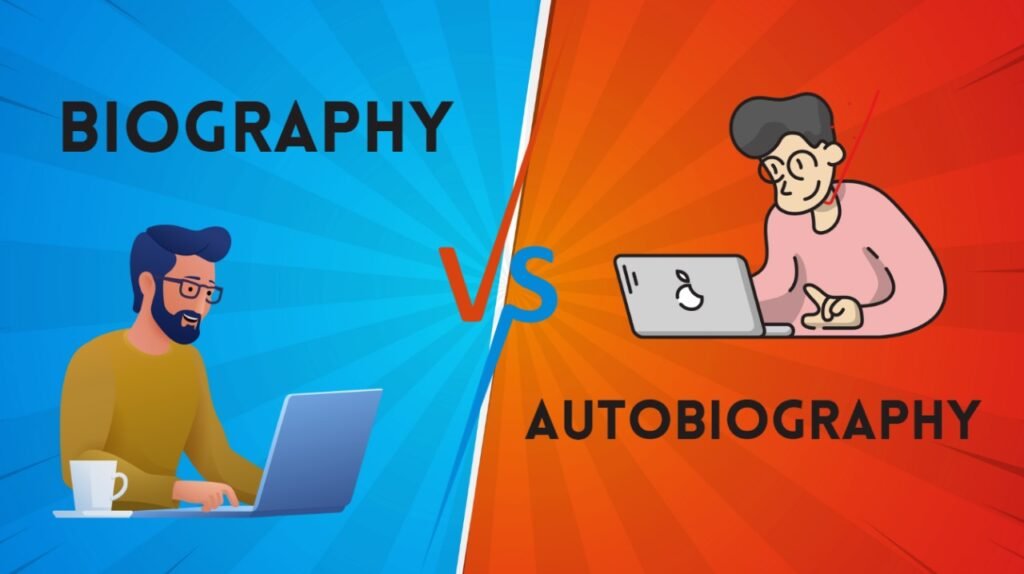Unveiling the Narrative Contrasts
Two distinguished threads weave difficult memories of human lives in the huge tapestry of literature: Biography vs. Autobiography. At the same time, these genres are interconnected in their exploration of personal histories and diverge substantially in their narrative nuances, dropping moderately on the complexities of storytelling and man or woman identification.
Deciphering the Essence of Biography
A Biography vs. Autobiography, like a scholarly tour, embarks on a quest to unravel the enigma of someone’s lifestyle. It is a meticulous agency orchestrated with the useful resource of a creator outside of the challenge, which traverses data, interviews, and ancient chronicles to piece together a complete portrait. Biographies encapsulate the essence of their topics, traversing landscapes of triumphs and tribulations and portraying an extensive range of their societal contributions and private odysseys.
The Introspective Journey of Autobiography
Conversely, an autobiography unveils a deeply non-public odyssey guided by the useful resource of the hand of its protagonist—the author. It is a soul-baring assignment, as the author excavates the recesses of memory and emotion to craft an intimate narrative. Autobiographies move beyond mere storytelling; they offer readers an unfiltered gaze into the author’s psyche as they navigate the labyrinthine corridors of self-discovery, resilience, and increase.
Pivotal Contrasts in Perspective
The External Lens of Biography
The crux of the difference between biography and autobiography lies in the vantage point from which the narrative unfolds. A biography is similar to a breathtaking vista, determined through the discerning lens of an intruder—a writer who sifts through the sands of time to gather a coherent narrative. It gives readers a kaleidoscopic view, synthesizing several viewpoints and interpretations to offer a multifaceted portrait of the concern.
The Intimate Gaze of Autobiography
In assessment, an autobiography invitations readers into the sanctum of the writer’s inner global, supplying an unfiltered glimpse into their thoughts, feelings, and tales. It is a tale sanctuary where authenticity reigns exceptional, and vulnerability becomes a guiding mild. Autobiographies are marked by the usage of their rawness and honesty as authors confront their demons, amuse their triumphs, and reconcile with the kaleidoscope in their private identities.00
Navigating the Authorial Terrain
The Duality of Authorship in Biography
A critical distinction between biography and autobiography lies within the realm of authorship. The writer is a diligent scribe in a biography, piecing together fragments of the assignment’s life to create a cohesive narrative. They encompass the location of historians and storytellers, weaving together disparate threads to create a tapestry of human revel.
The Singular Voice of Autobiography
Conversely, an autobiography bears the imprint of its sole architect—the author. They wield the pen as both sword and defense, navigating the tumultuous seas of reminiscence and emotion to craft a story that is uniquely their very private. Autobiographies are characterized through their singular voice, as authors reclaim agency over their memories, unearthing truths that lie dormant under layers of societal expectation and private mythos.
Converging Threads of Commonality
Shared Elements Amidst Diversity
Despite their disparate origins and narrative trajectories, biographies and autobiographies are not unusual threads that bind them together. Both genres feature vessels of human enjoyment and charting. The ebbs and flows of a person’s life in the direction of the backdrop of records and subculture. They are testimony to the resilience of the human spirit, supplying glimpses of desire, courage, and perseverance in the face of adversity.
Conclusion:
In the grand tapestry of literature, biographies, and autobiographies testify to the richness and kind of human experience. While they diverge in their narrative techniques and authorial perspectives, they converge on their shared dedication to storytelling and reality-seeking. Whether exploring the annals of facts or navigating the labyrinth of personal identification. Every genre’s characteristic beacons of perception and idea illuminate the human circumstance with extraordinary intensity and complexity.
FAQs: Biography vs. Autobiography
What is the number one distinction between a biography and an autobiography?
A biography is a written account of someone’s lifestyle. Usually authored with a useful resource of the use of someone aside from the issue. Presenting an out-of-door perspective based totally on research and evaluation. On the other hand, an autobiography is a firsthand narrative penned with the resources of the individual. Supplying a personal and subjective view of their lifestyle reviews.
How do the views vary between a biography and an autobiography?
In a biography, the angle is outside, offering insights into the protagonist’s life through the author’s eyes. Biographers use historical facts, interviews, and superb assets to create a narrative. In evaluation, an autobiography gives a firsthand mindset, allowing readers to enjoy activities through the author’s lens. Taking pictures of their thoughts, emotions, and reflections.
Who generally writes a biography, and who authors an autobiography?
Biographies are normally written with the useful resources of authors outside the trouble who undertake huge research to deliver a complete narrative. In assessment, autobiographies are authored by the humans whose lives are being stated. Giving them complete manipulation over the storytelling technique and contemplating a deeply private exploration. Their research.
How do biographies and autobiographies range in phrases of objectivity and subjectivity?
Biographies strive for objectivity, incorporating multiple viewpoints to supply a balanced and unbiased portrayal of the trouble’s existence. Autobiographies are inherently subjective, reflecting the writer’s private biases. Feelings, and interpretations in their non-public lifestyle studies, offering a more intimate and customized narrative.
What are some common factors shared via the usage of biographies and autobiographies?
Despite their versions, each biography and autobiography intends to record big events. Relationships, and milestones within the state of affairs’s lifestyles. They provide treasured insights into historical durations, cultural contexts, and societal norms. Giving readers a deeper knowledge of the human revel in several methods.
Read also:


